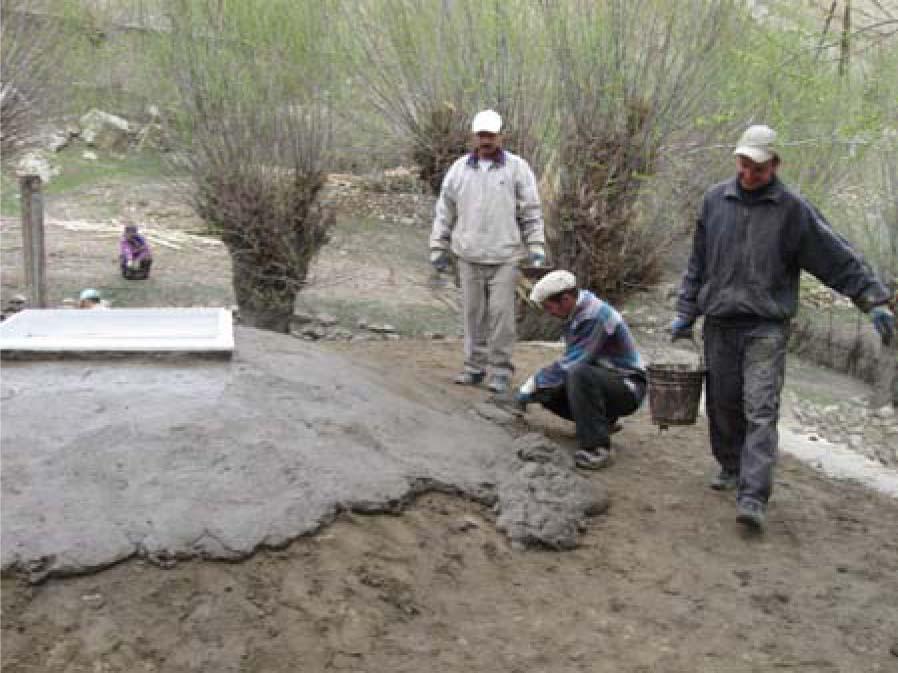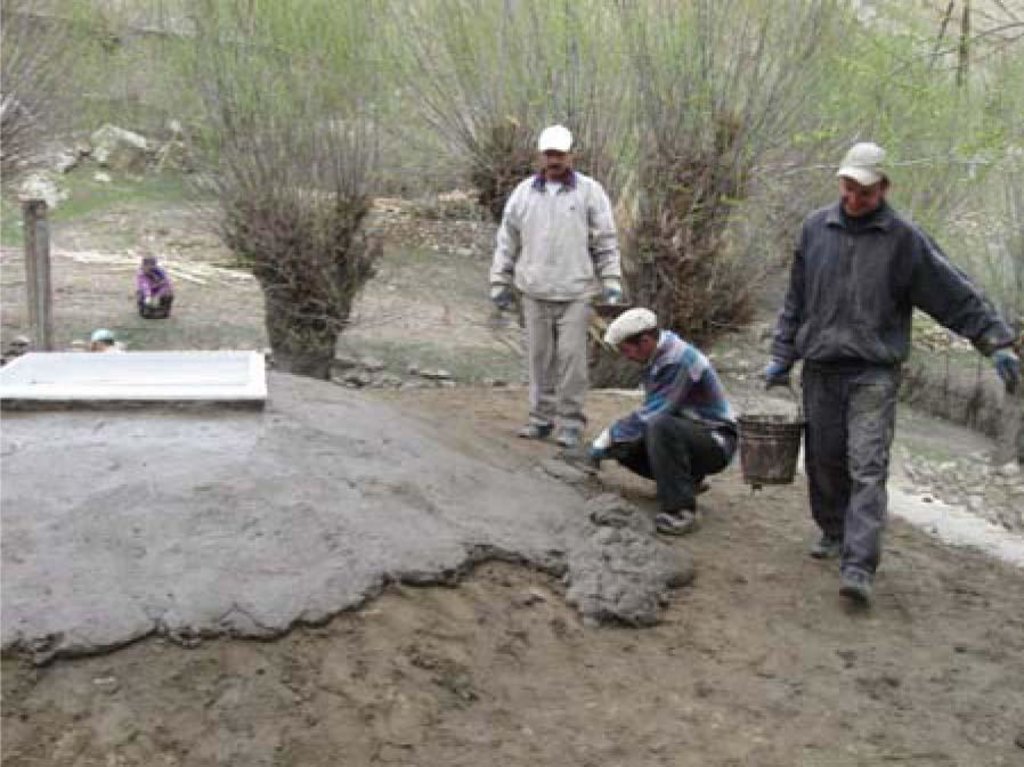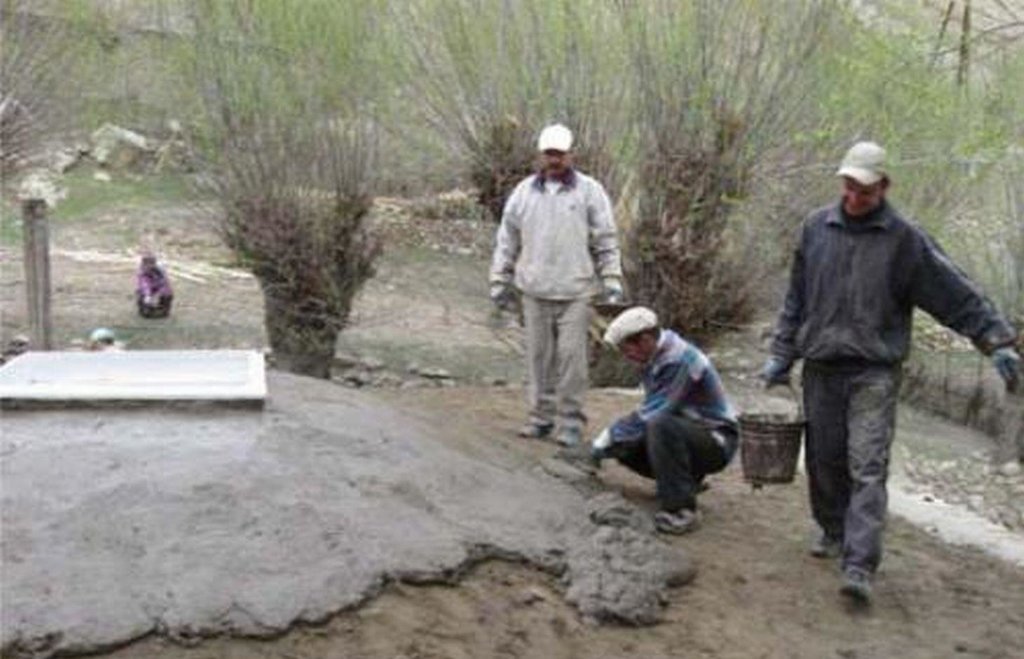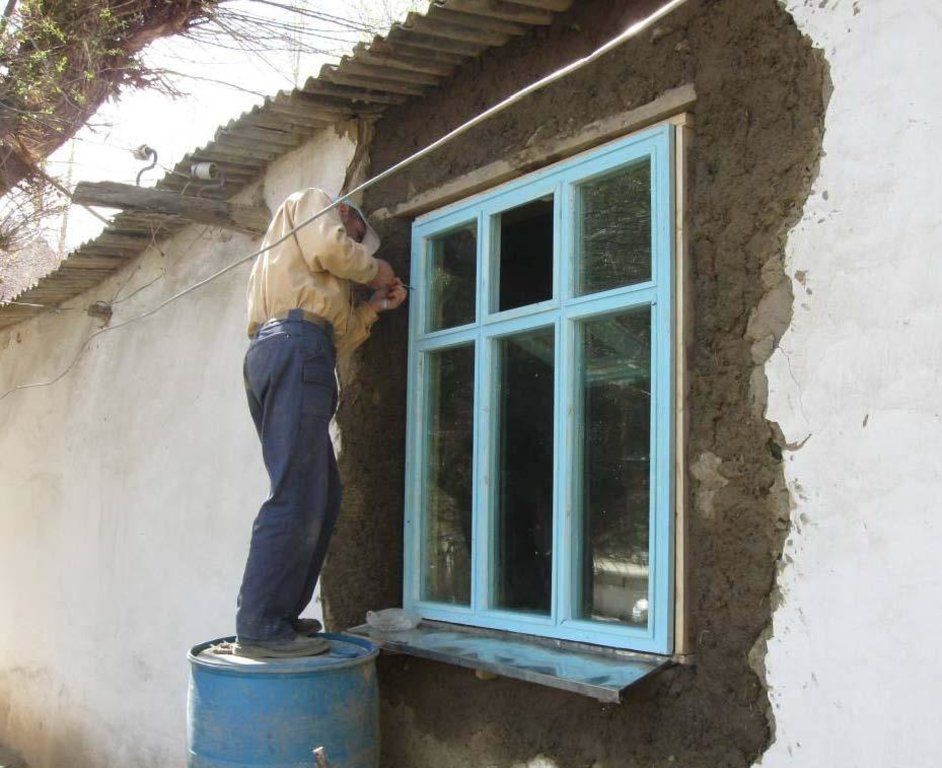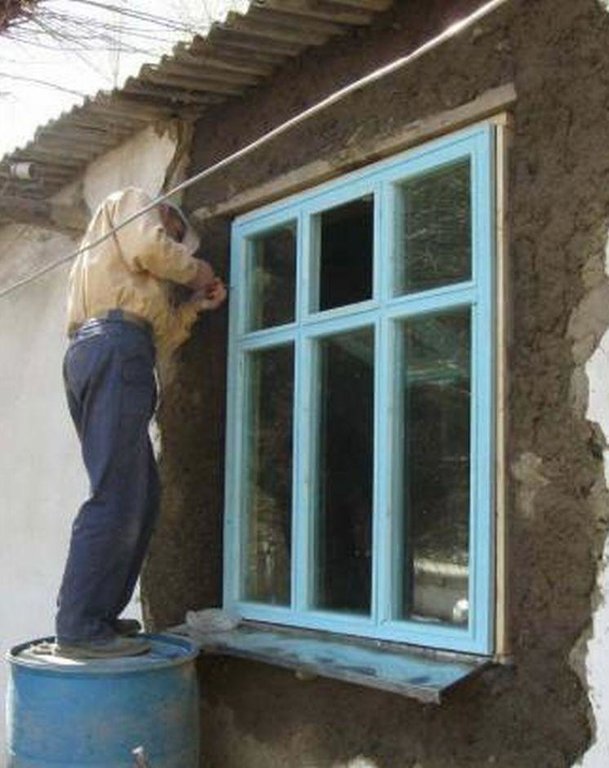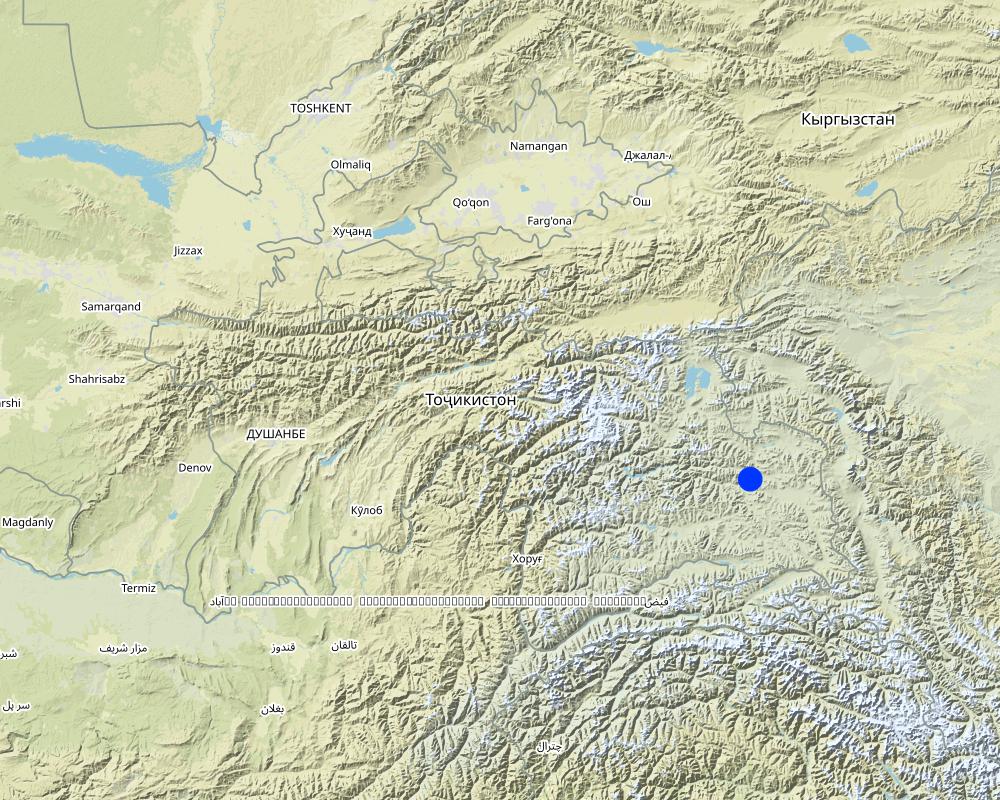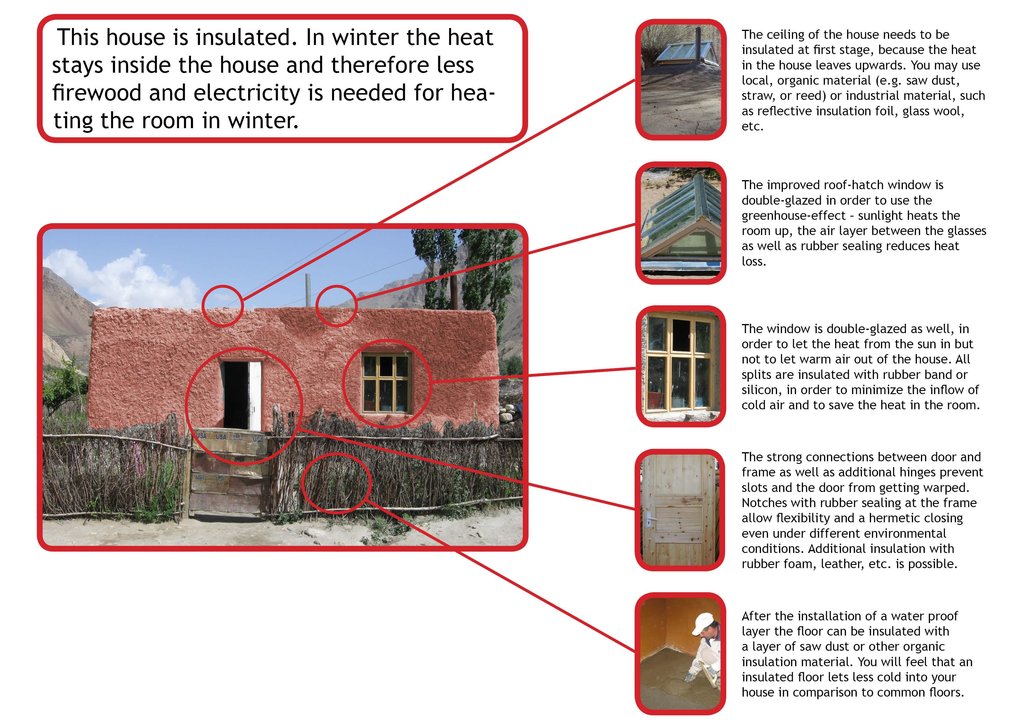Reduced pressure on forest resources by improved thermal insulation in private houses [Tajikistan]
- Creation:
- Update:
- Compiler: Roziya Kirgizbekova
- Editor: –
- Reviewers: Alexandra Gavilano, Deborah Niggli, Joana Eichenberger
Central Asian Countries Initiative for Land Management (CACILM/ИСЦАУЗР)
technologies_1459 - Tajikistan
- Full summary as PDF
- Full summary as PDF for print
- Full summary in the browser
- Full summary (unformatted)
- Reduced pressure on forest resources by improved thermal insulation in private houses: 4 يناير، 2017 (inactive)
- Reduced pressure on forest resources by improved thermal insulation in private houses: 19 يوليو، 2017 (inactive)
- Reduced pressure on forest resources by improved thermal insulation in private houses: 20 أغسطس، 2019 (inactive)
- Reduced pressure on forest resources by improved thermal insulation in private houses: 2 نوفمبر، 2021 (public)
View sections
Expand all Collapse all1. معلومات عامة
1.2 Contact details of resource persons and institutions involved in the assessment and documentation of the Technology
SLM specialist:
Zevarshoev Rustam
Retail Cooperative "Zindagi"
Tajikistan
Name of project which facilitated the documentation/ evaluation of the Technology (if relevant)
Central Asian Countries Initiative for Land Management (CACILM I)Name of project which facilitated the documentation/ evaluation of the Technology (if relevant)
Pilot Program for Climate Resilience, Tajikistan (WB / PPCR)1.3 Conditions regarding the use of data documented through WOCAT
The compiler and key resource person(s) accept the conditions regarding the use of data documented through WOCAT:
نعم
1.4 Declaration on sustainability of the described Technology
Is the Technology described here problematic with regard to land degradation, so that it cannot be declared a sustainable land management technology?
لا
1.5 Reference to Questionnaire(s) on SLM Approaches (documented using WOCAT)
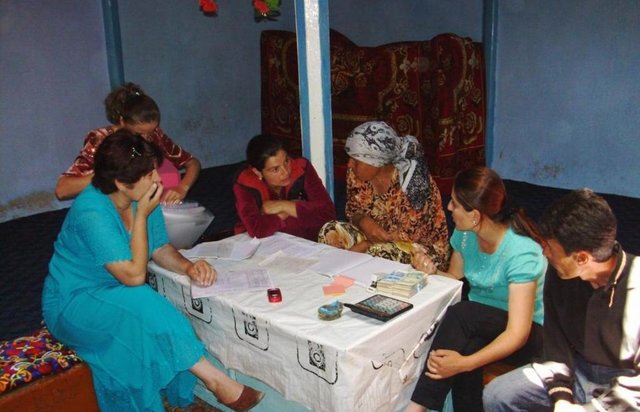
Access to thermal insulation through micro loans [Tajikistan]
Provision of small scale loans for private households to ensure access to thermal insulation (in the frame of CACILM).
- Compiler: Roziya Kirgizbekova
2. Description of the SLM Technology
2.1 Short description of the Technology
Definition of the Technology:
Thermal insulation of private houses with energy efficient products to reduce the fuel-wood demand and pressures on the natural environment.
2.2 Detailed description of the Technology
Description:
Well insulated doors and windows are installed together with thermal insulation of the ceilings and floors in houses in the remote villages of the Gorno-Badakhshan Autonomous Region. Improved quality windows and doors, as well as improved thermal insulation of the houses contribute to retain the heat inside, which is one of the main problems in many of these traditionally built houses. The quality of the materials used to produce the products as well as the quality of the product itself and its installation process are ensured through using locally trained craftsmen. Local available organic materials such as sawdust, straw, water plants, leaves and others can be used as thermal insulation material for walls, floors and ceilings. The materials should be dry and free of insects. The local labour market plays a crucial role in the technical accurate performance of the thermal insulation measures. Therefore the local labour market has to be analysed and training needs for the craftsmen have to be defined, e.g. for producing double-glazed windows and improved doors, as well as insulating walls, ceilings or floors, and the installation of windows and doors in accordance to the defined and standardised thermal insulation measu
Thermal insulation contributes to the reduction of heat exchange between indoors and outdoors and therefore may have two main effects: Less fuel may be needed to heat the houses, or using the same quantities of fuel the temperature indoors can be significantly increased. A reduction in fuel consumption means a reduction either of financial expenses or of labour, so the saved money or time can be used for other purposes - ideally for making investments and creating additional income sources. Higher and more constant indoor temperatures can contribute to a reduction in health risks and to increased quality of life during the winter period. Going beyond the level of the individual household, a reduction in fuel consumption means less pressure on natural resources: The less firewood that is used for heating, the less trees will be cut down and the less the forests will degrade. Also the less manure that is burnt in the stoves means more of it can be used as fertilizer on the arable land. In this framework many of the economical, social and environmental problems could be mitigated if houses were properly insulated.
A technical assessment of the identified house for thermal insulation is carried out to investigate which materials are used for the construction of the house, and to identify measures and materials that could be used for thermal insulation purposes, in order to be able to offer the most technically appropriate solution, which is adapted to the local cultural and climatic conditions. The organic thermal insulation material should be prepared in advance to make sure it is dry and clean. The designated area whether it is the floor, ceiling or walls should be cleared of furniture and other things items. Electric wires should be safely removed, or covered adequately for safety reasons to prevent fire. In the case of the roof, the insulation material is laid out evenly on the surface to a thickness of 15-20 cm depending on the type of organic material which is used. The lime is then spread out over the organic insulation material. For 1 m2 about 1-1.5kg of lime is required. The material is thoroughly tamped down to reduce subsidence of the protective cover, which will be put over the insulation material. A mixture of clay, straw and water is prepared to form a substance with a solid consistency to prevent the surface from cracking when it dries. This clay and straw mixture is then spread evenly on the surface about 4-6 cm thick, ensuring that the whole insulation material is covered. The surface should dry in 24 hours after which some cracks might appear and if this happens then a liquid mixture of clay and sand is used to flatten the area left to dry again. The same process is applied to the floors, and the more complex roof thermal insulation materials where roof felt is used as a basis for the organic insulation material as it is moisture proof. The windows and doors as well as these insulated areas in the house should be properly maintained. It should be ensures that there are no leaks in the roof so that the ceiling insulation is kept dry.
Riparian forests in the Western parts of Gorno-Badakhshan and Teresken shrubs on the high plains in the Eastern parts are almost completely destroyed due to their excessive use as a fuel for heating and cooking, and their overuse as areas for pastures. Manure, as one important natural fertilizer for agriculture, is no longer available in large quantities and so the fertility of soil has decreased. In the Eastern Pamirs, although the area is scarcely populated, Teresken shrubs have been used excessively as a fuel and are no longer found within 70km around the only major settlement of Murgab, which has resulted in massive soil erosion and degradation of pastures in this area. The situation is worsened by the fact that the local, mostly traditionally built houses are poorly insulated, low quality doors and windows do not preserve the heat inside during severe cold temperatures. Constant heating is thus necessary meaning households burn large amount of natural fuel resources to keep their houses warm. The thermal insulation technology should contribute to ease the pressure on the natural resources in the GBAO area and allow natural regeneration of forests and Teresken shrubs.
2.3 Photos of the Technology
2.5 Country/ region/ locations where the Technology has been applied and which are covered by this assessment
بلد:
Tajikistan
Region/ State/ Province:
Tajikistan, Gorno Badakhshan Autonomous Oblast (GBAO)
Further specification of location:
Roshtkala, Shugnan, Murgab and Ishkashim
Specify the spread of the Technology:
- evenly spread over an area
If precise area is not known, indicate approximate area covered:
- 100-1,000 km2
Comments:
The technology was implemented in several regions of GBAO.
Map
×2.6 Date of implementation
If precise year is not known, indicate approximate date:
- less than 10 years ago (recently)
2.7 Introduction of the Technology
Specify how the Technology was introduced:
- through projects/ external interventions
Comments (type of project, etc.):
The technology was developed and introduced through GIZ project. Gradually Retail Cooperative "Zindagi", established by GIZ is taking the project over.
3. Classification of the SLM Technology
3.1 Main purpose(s) of the Technology
- create beneficial economic impact
3.2 Current land use type(s) where the Technology is applied

Forest/ woodlands
- (Semi-)natural forests/ woodlands
(Semi-)natural forests/ woodlands: Specify management type:
- Selective felling
Products and services:
- Timber
- Fuelwood
- Fruits and nuts
- Grazing/ browsing

Settlements, infrastructure
- Energy: pipelines, power lines
Comments:
Major land use problems (compiler’s opinion): Due to a shortage of energy sources, wood, teresken and manure are extensively used for heating private houses; natural resources are therefore severely overused, which has resulted in degraded land, destroyed forests and lack of natural fertilizer for agriculture; poor thermal insulation of houses also leads to increased demand for fuel.
Major land use problems (land users’ perception): Unable to heat their houses properly during cold winters; shortage of fuel for cooking and heating; during cold winters, fire wood becomes so scarce that even fruit trees are cut down.
3.3 Has land use changed due to the implementation of the Technology?

Settlements, infrastructure
3.5 SLM group to which the Technology belongs
- energy efficiency technologies
3.6 SLM measures comprising the Technology

vegetative measures
- V5: Others

structural measures
- S11: Others

management measures
- M2: Change of management/ intensity level
3.7 Main types of land degradation addressed by the Technology

soil erosion by water
- Wt: loss of topsoil/ surface erosion

biological degradation
- Bc: reduction of vegetation cover
- Bq: quantity/ biomass decline
- Bs: quality and species composition/ diversity decline
Comments:
Main causes of degradation: over-exploitation of vegetation for domestic use (Exploiting forest resources for heating and cooking.), poverty / wealth (Most people can't afford to buy other fuel such as coal or gas.), Lack of finances
Secondary causes of degradation: change in temperature (Extremely cold winters force people to cut down excessive amounts of wood for fuel), change of seasonal rainfall (Less precipitation), Heavy / extreme rainfall (intensity/amounts) (Heavy periods of rainfall), population pressure (Population growth leads to increasing demand for wood for fuel.), Destroyed infrastructure
3.8 Prevention, reduction, or restoration of land degradation
Specify the goal of the Technology with regard to land degradation:
- prevent land degradation
4. Technical specifications, implementation activities, inputs, and costs
4.1 Technical drawing of the Technology
Technical specifications (related to technical drawing):
This diagram with photos shows the different thermal insulation measures.
Location: Ishkashim. Ishkashim, GBAO, Tajikisatan
Date: 26-02-2011
Technical knowledge required for field staff / advisors: high (Increased technical knowledge)
Technical knowledge required for craftsmen: high (Increased skills in producing well insulated doors and windows.)
Technical knowledge required for construction workers: high (Advanced skills in installation of thermal insulation products.)
Main technical functions: increase of biomass (quantity), Reduced heat loss from houses, Reduced fuel consumption
Secondary technical functions: improvement of topsoil structure (compaction), stabilisation of soil (eg by tree roots against land slides), increase in organic matter, increase in nutrient availability (supply, recycling,…), promotion of vegetation species and varieties (quality, eg palatable fodder)
Change of land use practices / intensity level
Author:
Tajikistan
4.2 General information regarding the calculation of inputs and costs
other/ national currency (specify):
somoni
If relevant, indicate exchange rate from USD to local currency (e.g. 1 USD = 79.9 Brazilian Real): 1 USD =:
4,6
4.3 Establishment activities
| Activity | Timing (season) | |
|---|---|---|
| 1. | Installation of window 1.40x1.30 | Any time |
| 2. | Installation of door 2.00x0.90 | |
| 3. | Thermal insulation |
4.4 Costs and inputs needed for establishment
| Specify input | Unit | Quantity | Costs per Unit | Total costs per input | % of costs borne by land users | |
|---|---|---|---|---|---|---|
| Labour | labour | ha | 1,0 | 17,0 | 17,0 | 100,0 |
| Construction material | door | ha | 1,0 | 133,0 | 133,0 | 100,0 |
| Construction material | window | ha | 1,0 | 126,0 | 126,0 | 100,0 |
| Construction material | Isolation material | ha | 1,0 | 126,0 | 126,0 | 100,0 |
| Total costs for establishment of the Technology | 402,0 | |||||
| Total costs for establishment of the Technology in USD | 87,39 | |||||
4.6 Costs and inputs needed for maintenance/ recurrent activities (per year)
Comments:
The labour costs are indicated for installation of one window/door. With regards to the thermal insulation the labour costs are higher, so they are calculated per square metre of the area where thermal insulation will be applied.
4.7 Most important factors affecting the costs
Describe the most determinate factors affecting the costs:
The costs for the installation of windows and doors depends on their size and also whether additional work has to be done to fit the door or window hatch to the required size. With regards to the thermal insulation the costs are estimated based of the size of the area in square metres, whether it is the floor, ceiling or wall.
5. Natural and human environment
5.1 Climate
Annual rainfall
- < 250 mm
- 251-500 mm
- 501-750 mm
- 751-1,000 mm
- 1,001-1,500 mm
- 1,501-2,000 mm
- 2,001-3,000 mm
- 3,001-4,000 mm
- > 4,000 mm
Specifications/ comments on rainfall:
In Murghab District annual rainfall is below 200mm. Around Khorog annual rainfall is 480mm.
Agro-climatic zone
- arid
Thermal climate class: temperate, boreal
5.2 Topography
Slopes on average:
- flat (0-2%)
- gentle (3-5%)
- moderate (6-10%)
- rolling (11-15%)
- hilly (16-30%)
- steep (31-60%)
- very steep (>60%)
Landforms:
- plateau/plains
- ridges
- mountain slopes
- hill slopes
- footslopes
- valley floors
Altitudinal zone:
- 0-100 m a.s.l.
- 101-500 m a.s.l.
- 501-1,000 m a.s.l.
- 1,001-1,500 m a.s.l.
- 1,501-2,000 m a.s.l.
- 2,001-2,500 m a.s.l.
- 2,501-3,000 m a.s.l.
- 3,001-4,000 m a.s.l.
- > 4,000 m a.s.l.
5.3 Soils
Soil depth on average:
- very shallow (0-20 cm)
- shallow (21-50 cm)
- moderately deep (51-80 cm)
- deep (81-120 cm)
- very deep (> 120 cm)
Soil texture (topsoil):
- coarse/ light (sandy)
Topsoil organic matter:
- medium (1-3%)
- low (<1%)
5.4 Water availability and quality
Ground water table:
5-50 m
Availability of surface water:
good
Water quality (untreated):
good drinking water
5.5 Biodiversity
Species diversity:
- high
5.6 Characteristics of land users applying the Technology
Market orientation of production system:
- subsistence (self-supply)
Off-farm income:
- > 50% of all income
Relative level of wealth:
- poor
- average
Individuals or groups:
- individual/ household
Gender:
- women
- men
Indicate other relevant characteristics of the land users:
Land users applying the Technology are mainly Leaders / privileged
Population density: 10-50 persons/km2
Annual population growth: 2% - 3% (If creditworthy, they can participate through micro-loans schemes.).
Off-farm income specification: The majority of households rely heavily on remittances from Russia.
5.7 Average area of land used by land users applying the Technology
- < 0.5 ha
- 0.5-1 ha
- 1-2 ha
- 2-5 ha
- 5-15 ha
- 15-50 ha
- 50-100 ha
- 100-500 ha
- 500-1,000 ha
- 1,000-10,000 ha
- > 10,000 ha
Is this considered small-, medium- or large-scale (referring to local context)?
- small-scale
5.8 Land ownership, land use rights, and water use rights
Land ownership:
- state
Land use rights:
- leased
5.9 Access to services and infrastructure
health:
- poor
- moderate
- good
education:
- poor
- moderate
- good
technical assistance:
- poor
- moderate
- good
employment (e.g. off-farm):
- poor
- moderate
- good
markets:
- poor
- moderate
- good
energy:
- poor
- moderate
- good
roads and transport:
- poor
- moderate
- good
drinking water and sanitation:
- poor
- moderate
- good
financial services:
- poor
- moderate
- good
6. Impacts and concluding statements
6.1 On-site impacts the Technology has shown
Socio-economic impacts
Production
fodder production
fodder quality
animal production
Income and costs
farm income
Comments/ specify:
Save money from buying fuel and electricity
diversity of income sources
Comments/ specify:
Income of craftsmen increased.
workload
Comments/ specify:
Less time needed for fire wood collection
Socio-cultural impacts
health situation
Comments/ specify:
Warmer houses reduce health risks.
SLM/ land degradation knowledge
Comments/ specify:
Improved knowledge on energy efficiency and insulation measures.
conflict mitigation
situation of socially and economically disadvantaged groups
Comments/ specify:
Opportunity to improve living conditions and save money.
contribution to human well-being
Comments/ specify:
In general, people save money on energy sources and spend less time collecting wood and animal dung from the field. Houses are warmer, which can be beneficial for the family's health.
Ecological impacts
Water cycle/ runoff
surface runoff
evaporation
Soil
soil moisture
soil cover
Biodiversity: vegetation, animals
biomass/ above ground C
Comments/ specify:
Up to 45% less wood used for fuel.
plant diversity
habitat diversity
Comments/ specify:
In Murghab District teresken used as fire wood is the main fodder for wild animals (e.g. deer, gazelles)
6.2 Off-site impacts the Technology has shown
reliable and stable stream flows in dry season
Comments/ specify:
Protection of riparian forests.
downstream flooding
Comments/ specify:
Protection of riparian forests.
buffering/ filtering capacity
wind transported sediments
damage on neighbours' fields
damage on public/ private infrastructure
6.3 Exposure and sensitivity of the Technology to gradual climate change and climate-related extremes/ disasters (as perceived by land users)
Gradual climate change
Gradual climate change
| Season | increase or decrease | How does the Technology cope with it? | |
|---|---|---|---|
| annual temperature | increase | well |
Climate-related extremes (disasters)
Meteorological disasters
| How does the Technology cope with it? | |
|---|---|
| local rainstorm | well |
| local windstorm | not known |
Climatological disasters
| How does the Technology cope with it? | |
|---|---|
| drought | well |
Hydrological disasters
| How does the Technology cope with it? | |
|---|---|
| general (river) flood | not known |
Other climate-related consequences
Other climate-related consequences
| How does the Technology cope with it? | |
|---|---|
| reduced growing period | well |
| Extreme cold temperatures | well |
6.4 Cost-benefit analysis
How do the benefits compare with the establishment costs (from land users’ perspective)?
Short-term returns:
slightly positive
Long-term returns:
positive
How do the benefits compare with the maintenance/ recurrent costs (from land users' perspective)?
Short-term returns:
very positive
Long-term returns:
very positive
6.5 Adoption of the Technology
Comments:
168 land user families have adopted the Technology without any external material support
The households take a micro loan with an affordable low interest rate to install thermal insulation products. The micro loan is not provided in the form of cash, but in kind, i.e. the products and installation.
There is a moderate trend towards spontaneous adoption of the Technology
Comments on adoption trend: When one household installs quality windows or doors or has its house insulated, the effects are visible not only to that given household but also to neighbours and other visitors. As a result the number of people interested in installing such technology to their homes is increasing.
6.7 Strengths/ advantages/ opportunities of the Technology
| Strengths/ advantages/ opportunities in the land user’s view |
|---|
| Costs of firewood reduced |
| Warm and comfortable houses |
| Reduced workload |
| Strengths/ advantages/ opportunities in the compiler’s or other key resource person’s view |
|---|
| If implemented on a larger scale can prevent overuse of natural resources for fuel. |
| Incentives in form of micro loans to make the technology more accessible to local people. |
| Reduced workload and costs spent on buying fuel. |
| Imported timber used to produce doors and windows. |
| More fertilizer available. |
6.8 Weaknesses/ disadvantages/ risks of the Technology and ways of overcoming them
| Weaknesses/ disadvantages/ risks in the compiler’s or other key resource person’s view | How can they be overcome? |
|---|---|
| Lack of skilled craftsmen | Improved professional craftsmen education through training courses. |
| Lack of modern equipment to produce wooden products | Financial support to supply the local craftsmen with modern equipment to further improve the quality of the products and increase the rate the production process. |
7. References and links
7.1 Methods/ sources of information
- field visits, field surveys
- interviews with land users
When were the data compiled (in the field)?
24/01/2011
Links and modules
Expand all Collapse allLinks

Access to thermal insulation through micro loans [Tajikistan]
Provision of small scale loans for private households to ensure access to thermal insulation (in the frame of CACILM).
- Compiler: Roziya Kirgizbekova
Modules
No modules


